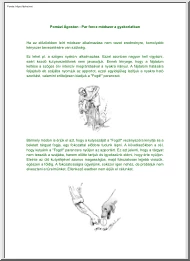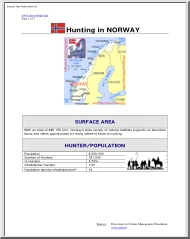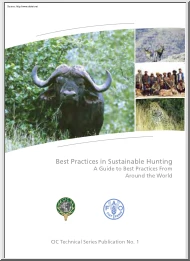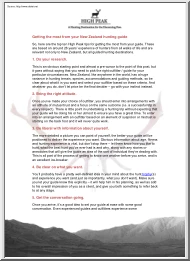Datasheet
Year, pagecount:2013, 9 page(s)
Language:English
Downloads:1
Uploaded:February 25, 2019
Size:2 MB
Institution:
-
Comments:
Attachment:-
Download in PDF:Please log in!
Comments
No comments yet. You can be the first!Content extract
Source: http://www.doksinet U.S Forces Europe Hunting, Fishing, and Sport Shooting Program Guide to Hunting in Germany 15 – HUNTING TRADITIONS (JAGDLICHES BRAUCHTUM) The hunting traditions that have evolved during the last centuries are as important to the German hunters as the actual search for the game. These customs have been handed over from father to son. A violation of these customs sometimes is considered as serious as a violation of the written law. US hunters must fully understand these customs and imitate their German hosts in observing them. Important traditions are: Waidmannsheil / Weidmannsheil, Waidmannsdank / Weidmannsdank One of the first customs notice by the new hunter is the use of “Waidmannsheil” and “Waidmannsdank”. Waidmannsheil is a greeting exchanged when two or more hunters meet or separate, when a hunter joins a group of hunters, and the congratulation for a successful hunt. The response to the greeting is the same “Waidmannsheil” When placing
a hunter on a stand or positioning a hunter for a drive hunt, the hunt organizer or Jagdaufseher will normally say “Waidmannsheil” and the correct response is “Waidmannsheil”, as both are wishing each other good luck and a successful hunt. The hunter responds with “Waidmannsdank” when accepting congratulations for a successful shot. Waidmannsdank is an appropriate reply in any situation in which one would say “thanks”. The difference in spelling Waidmannsheil or Weidmannsheil is based on cultural change and regional / local preferences. It is best to determine which version is used locally and then use the same version when communicating in writing. Branch Signs (Bruchzeichen) Branches are used in many ways in the hunt. The use of branch signs is interesting as well as practical. The branches are always broken from trees Hunters break the branches only from trees native to Germany. These trees include Alder( Erle), Fir (Tanne), Oak (Eiche), Pine (Kiefer), and Spruce
(Fichte). 11-1 Source: http://www.doksinet U.S Forces Europe Hunting, Fishing, and Sport Shooting Program Guide to Hunting in Germany Among the more common branch signs are: 11-2 Source: http://www.doksinet U.S Forces Europe Hunting, Fishing, and Sport Shooting Program Guide to Hunting in Germany Shot Branch (Anschussbruch) An arm-length branch that is broken off from the tree and stuck into the ground at the point where game has sustained or may have sustained a wound. The shot branch is used to aid in the search for the crippled animal. A shot branch will only make sense if it can be found easily, even hours after the shot has been fired. If undergrowth or trees make it hard to spot a shot branch, it is common to use a fluorescent ribbon to mark the point where the animal was hit by the bullet. Shot Branch (Anschussbruch) 11-3 Source: http://www.doksinet U.S Forces Europe Hunting, Fishing, and Sport Shooting Program Guide to Hunting in Germany Warning Branch
(Warnbruch) The warning branch is a branch from which the limbs and bark of the lower section are removed and that then is formed into a circle or loop. The warning branch is hung from a tree or other conspicuous object indicating danger in the vicinity (for example, a trap, poachers, or an unsafe high seat). Warning Branch (Warnbruch) Ownership Branch (Inbesitznahmebruch) A small branch placed pointing toward the head of the animal after the animal is killed and laid on its right side. For male animals, the broken end of the branch points toward the head. For female animals, the tip of the branch points toward the head. Last Bite (Letzter Bissen) A small branch placed crosswise in the mouth of all male cloven hoofed game as a token of last respect. 11-4 Source: http://www.doksinet U.S Forces Europe Hunting, Fishing, and Sport Shooting Program Guide to Hunting in Germany Last Bite, ownership branch, and hunter’s branch (Letzter Bissen, Inbesitznahmebruch, und Schützenbruch)
11-5 Source: http://www.doksinet U.S Forces Europe Hunting, Fishing, and Sport Shooting Program Guide to Hunting in Germany Hunter’s Branch (Schützenbruch) The hunter’s branch is a branch that is dipped into the blood of cloven hoofed game following the kill. The branch is then placed on a hunting hat and presented to the successful hunter with the word “Waidmannsheil”. The hunter responds with “Waidmannsdank” and places the branch at the right side of their hat with the upper side of the branch outward. When wounded game is tracked down by a dog, the dog handler will present the branch to the hunter. The hunter will return a piece of the branch to the dog handler who, in turn, breaks off another piece and puts it in the dog’s collar. When hunting alone, the hunter should remember to place the hunter’s branch in their own hat. Receiving the hunter’s branch (Schützenbruch) 11-6 Source: http://www.doksinet U.S Forces Europe Hunting, Fishing, and Sport
Shooting Program Guide to Hunting in Germany 1A Red deer stag with last bite, ownership branch, and hunter’s branch (1A Rothirsh mit Letzter Bissen, Inbesitznahmebruch, und Schützenbruch) Hunter dialect (Jägersprache) Over the centuries, a special language has developed among hunters. For instance, the tail of an animal in standard German is Schwanz. However, in Jägersprache, the tail of a rabbit or hare is the Blume; for a fox, the tail is a Lunte; for a wild boar, the tail is a Pürzel; f o r a red deer, the tail is a Wedel; and for a hunting dog, the tail is a Fahne. For more information on hunter dialect, please see the section “Jägersprache”. Invitations (Einladungen) Hunting invitations are personal and may be accepted only by the person to whom they are extended. It is improper to bring additional guests to a hunt 11-7 Source: http://www.doksinet U.S Forces Europe Hunting, Fishing, and Sport Shooting Program Guide to Hunting in Germany Hubertus – Patron Saint
of Hunters (Hubertus-Schutzpatron der Jäger) Saint Hubert lived from 656 to 727 in the Lüttich area of Belgium. He was the Bishop of Maastricht and Liège, Belgium. According to legend, Saint Hubert was an avid hunter until the fateful day when he had a vision. In his vision Saint Hubert encountered a Red Deer stag with a golden cross between its antlers. The stag reproached him for his excessive killing Saint Hubert was thereby converted to asceticism, and from then on he devoted his life to the service of God and God’s creatures. European hunters have chosen Saint Hubert as their patron saint. The Sankt Hubertus holiday is observed by hunters in Germany on 03 November. For most hunters it is the day for reconciliation and recollection in the spirit of Saint Hubert. German hunting clubs arrange various special activities (for example, Hubertus drive hunts, Hubertus masses, social gatherings) on this day. Sportsmanship (Waidgerechtigkeit) In Germany, Waidgerechtigkeit is a
combination of customs, traditions, and good hunting practices. One aspect is the observance of German customs and traditions. Customs and traditions change and the same custom may differ slightly from one area to another. U.S Forces personnel will find that skill in the observance of customs and traditions will come only through attentiveness and experience. Waidgerechtigkeit requires that hunters make clean kills. Ammunition size plays an important role in the hunter’s ability to make a clean kill. As a general practice good hunters do not shoot at game using shotguns beyond the 35- meter range mark. Hunter should always avoid crippling game Minimum shot sizes (When using steel shot, use one size higher): Fox Geese and Hare Rabbit Pheasant and Duck Partridge 3.5 to 4 mm 3.5 to 4 mm 2.5 to 3 mm 3.0 mm 2.5 mm A hunter who wounds an animal will mark the spot where the animal was wounded and will be available for the mandatory search. 11-8 Source: http://www.doksinet U.S Forces
Europe Hunting, Fishing, and Sport Shooting Program Guide to Hunting in Germany Normally hunters will shoot only birds that are in full flight. Two exceptions are the Black Grouse and the Capercaillie. The Black Grouse may be shot on the ground while performing his strutting act and mating dance. The Capercaillie may be shot while perched in a tree performing his mating ritual. Crippled birds also may be shot when not in full flight to stop them from escaping. Waidgerechtigkeit promotes “one shot – one kill” philosophy. The objective is not to see how much ammunition the hunter can use but rather to use as few shots as possible. A good hunter will do their best to make a clean kill with every shot and they will track (or obtain assistance in tracking) any animal that has been wounded. By German standards, hunting is not a sport or a hobby; it is a mission of public concern. The responsible hunter carries out this mission in an attempt to maintain a stock of healthy wildlife in
numbers and variety that is consistent with the capacity of the wildlife habitat. The conversion of Saint Hubert, 1485-90, artist unknown (Die Bekehrung des heiligen Hubertus) 11-9
a hunter on a stand or positioning a hunter for a drive hunt, the hunt organizer or Jagdaufseher will normally say “Waidmannsheil” and the correct response is “Waidmannsheil”, as both are wishing each other good luck and a successful hunt. The hunter responds with “Waidmannsdank” when accepting congratulations for a successful shot. Waidmannsdank is an appropriate reply in any situation in which one would say “thanks”. The difference in spelling Waidmannsheil or Weidmannsheil is based on cultural change and regional / local preferences. It is best to determine which version is used locally and then use the same version when communicating in writing. Branch Signs (Bruchzeichen) Branches are used in many ways in the hunt. The use of branch signs is interesting as well as practical. The branches are always broken from trees Hunters break the branches only from trees native to Germany. These trees include Alder( Erle), Fir (Tanne), Oak (Eiche), Pine (Kiefer), and Spruce
(Fichte). 11-1 Source: http://www.doksinet U.S Forces Europe Hunting, Fishing, and Sport Shooting Program Guide to Hunting in Germany Among the more common branch signs are: 11-2 Source: http://www.doksinet U.S Forces Europe Hunting, Fishing, and Sport Shooting Program Guide to Hunting in Germany Shot Branch (Anschussbruch) An arm-length branch that is broken off from the tree and stuck into the ground at the point where game has sustained or may have sustained a wound. The shot branch is used to aid in the search for the crippled animal. A shot branch will only make sense if it can be found easily, even hours after the shot has been fired. If undergrowth or trees make it hard to spot a shot branch, it is common to use a fluorescent ribbon to mark the point where the animal was hit by the bullet. Shot Branch (Anschussbruch) 11-3 Source: http://www.doksinet U.S Forces Europe Hunting, Fishing, and Sport Shooting Program Guide to Hunting in Germany Warning Branch
(Warnbruch) The warning branch is a branch from which the limbs and bark of the lower section are removed and that then is formed into a circle or loop. The warning branch is hung from a tree or other conspicuous object indicating danger in the vicinity (for example, a trap, poachers, or an unsafe high seat). Warning Branch (Warnbruch) Ownership Branch (Inbesitznahmebruch) A small branch placed pointing toward the head of the animal after the animal is killed and laid on its right side. For male animals, the broken end of the branch points toward the head. For female animals, the tip of the branch points toward the head. Last Bite (Letzter Bissen) A small branch placed crosswise in the mouth of all male cloven hoofed game as a token of last respect. 11-4 Source: http://www.doksinet U.S Forces Europe Hunting, Fishing, and Sport Shooting Program Guide to Hunting in Germany Last Bite, ownership branch, and hunter’s branch (Letzter Bissen, Inbesitznahmebruch, und Schützenbruch)
11-5 Source: http://www.doksinet U.S Forces Europe Hunting, Fishing, and Sport Shooting Program Guide to Hunting in Germany Hunter’s Branch (Schützenbruch) The hunter’s branch is a branch that is dipped into the blood of cloven hoofed game following the kill. The branch is then placed on a hunting hat and presented to the successful hunter with the word “Waidmannsheil”. The hunter responds with “Waidmannsdank” and places the branch at the right side of their hat with the upper side of the branch outward. When wounded game is tracked down by a dog, the dog handler will present the branch to the hunter. The hunter will return a piece of the branch to the dog handler who, in turn, breaks off another piece and puts it in the dog’s collar. When hunting alone, the hunter should remember to place the hunter’s branch in their own hat. Receiving the hunter’s branch (Schützenbruch) 11-6 Source: http://www.doksinet U.S Forces Europe Hunting, Fishing, and Sport
Shooting Program Guide to Hunting in Germany 1A Red deer stag with last bite, ownership branch, and hunter’s branch (1A Rothirsh mit Letzter Bissen, Inbesitznahmebruch, und Schützenbruch) Hunter dialect (Jägersprache) Over the centuries, a special language has developed among hunters. For instance, the tail of an animal in standard German is Schwanz. However, in Jägersprache, the tail of a rabbit or hare is the Blume; for a fox, the tail is a Lunte; for a wild boar, the tail is a Pürzel; f o r a red deer, the tail is a Wedel; and for a hunting dog, the tail is a Fahne. For more information on hunter dialect, please see the section “Jägersprache”. Invitations (Einladungen) Hunting invitations are personal and may be accepted only by the person to whom they are extended. It is improper to bring additional guests to a hunt 11-7 Source: http://www.doksinet U.S Forces Europe Hunting, Fishing, and Sport Shooting Program Guide to Hunting in Germany Hubertus – Patron Saint
of Hunters (Hubertus-Schutzpatron der Jäger) Saint Hubert lived from 656 to 727 in the Lüttich area of Belgium. He was the Bishop of Maastricht and Liège, Belgium. According to legend, Saint Hubert was an avid hunter until the fateful day when he had a vision. In his vision Saint Hubert encountered a Red Deer stag with a golden cross between its antlers. The stag reproached him for his excessive killing Saint Hubert was thereby converted to asceticism, and from then on he devoted his life to the service of God and God’s creatures. European hunters have chosen Saint Hubert as their patron saint. The Sankt Hubertus holiday is observed by hunters in Germany on 03 November. For most hunters it is the day for reconciliation and recollection in the spirit of Saint Hubert. German hunting clubs arrange various special activities (for example, Hubertus drive hunts, Hubertus masses, social gatherings) on this day. Sportsmanship (Waidgerechtigkeit) In Germany, Waidgerechtigkeit is a
combination of customs, traditions, and good hunting practices. One aspect is the observance of German customs and traditions. Customs and traditions change and the same custom may differ slightly from one area to another. U.S Forces personnel will find that skill in the observance of customs and traditions will come only through attentiveness and experience. Waidgerechtigkeit requires that hunters make clean kills. Ammunition size plays an important role in the hunter’s ability to make a clean kill. As a general practice good hunters do not shoot at game using shotguns beyond the 35- meter range mark. Hunter should always avoid crippling game Minimum shot sizes (When using steel shot, use one size higher): Fox Geese and Hare Rabbit Pheasant and Duck Partridge 3.5 to 4 mm 3.5 to 4 mm 2.5 to 3 mm 3.0 mm 2.5 mm A hunter who wounds an animal will mark the spot where the animal was wounded and will be available for the mandatory search. 11-8 Source: http://www.doksinet U.S Forces
Europe Hunting, Fishing, and Sport Shooting Program Guide to Hunting in Germany Normally hunters will shoot only birds that are in full flight. Two exceptions are the Black Grouse and the Capercaillie. The Black Grouse may be shot on the ground while performing his strutting act and mating dance. The Capercaillie may be shot while perched in a tree performing his mating ritual. Crippled birds also may be shot when not in full flight to stop them from escaping. Waidgerechtigkeit promotes “one shot – one kill” philosophy. The objective is not to see how much ammunition the hunter can use but rather to use as few shots as possible. A good hunter will do their best to make a clean kill with every shot and they will track (or obtain assistance in tracking) any animal that has been wounded. By German standards, hunting is not a sport or a hobby; it is a mission of public concern. The responsible hunter carries out this mission in an attempt to maintain a stock of healthy wildlife in
numbers and variety that is consistent with the capacity of the wildlife habitat. The conversion of Saint Hubert, 1485-90, artist unknown (Die Bekehrung des heiligen Hubertus) 11-9





